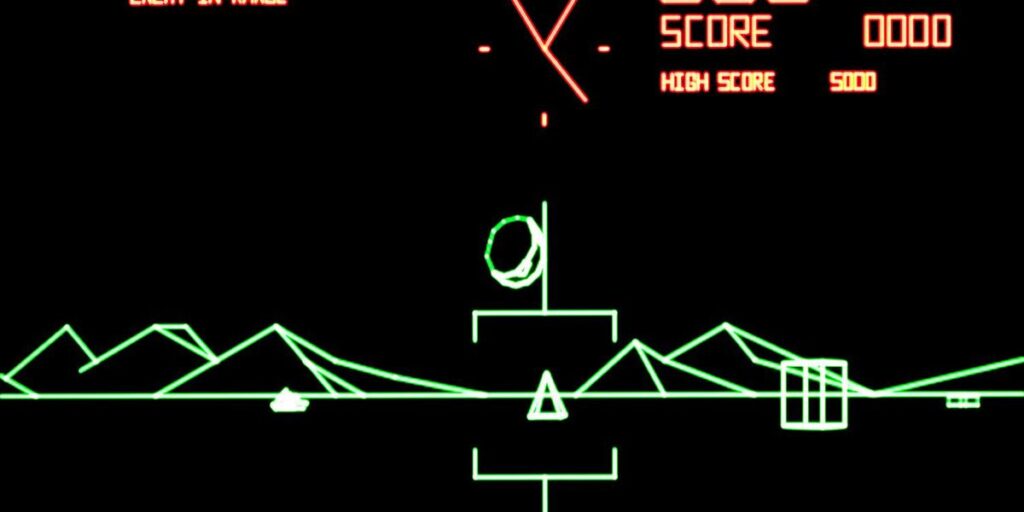Three-dimensional displays first appeared on computer screens in the 1960s, and very large machines could manipulate those images in real time, but it was not until 1980 that a video-game player could maneuver at will through an imaginary landscape, wreaking havoc until brought to an untimely end by enemy tanks. Battlezone, a first-person tank game, was made possible by a vector display unit used by Atari Inc., Sunnyvale, Calif., in Asteroids, which came out the previous year.
Even with the vector generator, according to Videa’s Ed Rotberg, who wrote computer code for the game, Battlezone required three microprocessors: a 6502 to control the game play, a custom processor for the display, and another, built from 2901 bit-slice processors, for the mathematics. The display generator and the game microprocessor operated either in parallel or in sequence with the others.
“It was pretty fast,” said Mr. Rotberg. “Quite often it wasn’t worth going off and doing something else—you just waited for the math box to finish.”
What the math box in Battlezone does is solve the matrix equations for vanishing-point perspective for all of the objects on the screen. To bring the problem within reach, the game is restricted to movement on a horizontal plane, reducing the matrix from 4 by 4 to 2 by 2. Much of the early work in designing Battlezone, Mr. Rotberg said, was involved in “figuring out how to organize the data.”
This article was first published as “Battlezone: war in 3-D.” It appeared in the December 1982 issue of IEEE Spectrumas part of a special report, “Video games: The electronic big bang.” A PDF version is available on IEEE Xplore.
Because Battlezone is a vector game, objects consist simply of points connected by lines, rather than entire filled regions, as a raster game would have. Even so, controlling the number of objects on the screen stretched the abilities of the three microprocessors, and Mr. Rotberg had to go to his graphic designer, Roger Hector, who also helped define the game play, to ask: “Could you do the same thing in less lines, less vertices?”
Although Battlezone does not deal with the hidden-line problem, it does use diminished brightness to indicate distance, and, like any vector-drawing system, it most cope with the problems of clipping—that is, deciding what objects are on the screen and what to do about objects that are partly on the screen and partly off.
“We did an end run around the problem,” said Mr. Rotberg. “The hardware lets you draw about half a screen off each side, which helps considerably. You calculate where the center points are and determine whether or not you’re going to display an object, and if you are, you draw all its lines regardless of whether or not they’ll be on the screen.”
There is only one problem with this approach: if an object is very close, it may suddenly disappear from the screen, because its center point has moved off screen, even though some lines should still remain on the screen. But, noted Mr. Rotberg, “if we didn’t do it that way we’d be instructing the vector generator to draw lines past where it could, and it would go off into the ozone.”
Battlezone took 15 months to develop, from the beginning of design to production. Some features, like an erupting volcano on the horizon, went into the game because they were fun and there was time to do them, Mr. Rotberg said.
“Early in the game there is a lack of a sense of urgency,” he noted. “You can stroll around and blow tanks up or not. A modification would be to give you a goal other than blowing up tanks.”
“One of the reasons engineers worked for Atari instead of working for the Government or a corporation doing Government contracts was that [military] is not the kind of work we want to be doing.”
If he had the game to do over again with today’s technology, Mr. Rotberg said, he would change it even more: instead of a monochrome display, a color vector display could be used, and newer microprocessors and cheaper memory could add realism and complexity.
Mr. Rotberg did do a version of Battlezone with added realism and complexity, but only under duress. It is called Army Battlezone, and it features a rolling landscape and images of U.S. and Soviet tanks. A company under contract to the Army to find training uses for video games approached Atari just as Battlezone was going into production, Mr. Rotberg said. He related:
“They had no idea it existed, saw it in the lobby, and said, ‘That’s what we want.’ And someone at Atari said, ‘We could make it just what you want.’ This was in December. They said the Army was having a meeting of the training centers in March, could Atari make it to their specifications by then?
“I said I didn’t want anything to do with the project. I was vehemently against it, but it became readily apparent that there was no one else familiar enough with the software in Battlezone to make the modifications by March. We had a formal brainstorming session, and I got into a loud shouting match with Joe Robbins, then president of Atari’s coin-op division, about Army Battlezone. I felt one of the reasons engineers worked for Atari instead of working for the Government or for a corporation doing Government contracts was that it [military] is not the kind of work we want to be doing. And with talk about games being violent and molding the minds of children, it couldn’t possibly be good press.
“I ended up losing three months of my life, spending every waking minute at Atari, coming home at 1 a.m., going in at 6 a.m. The game got done.”
From Your Site Articles
Related Articles Around the Web


